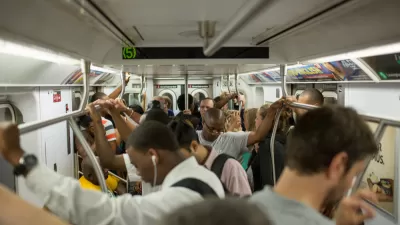Detailed animations of ventilation systems in New York City subway cars provide transit riders with a better understanding of the possibility of community spread in subway cars.

Former public transit riders wary of returning to New York subways might cite uncertainty about safety conditions and community spread as a reason for avoiding the popular form of transportation. Doing their part to arm the public with information, Mika Gröndahl, Christina Goldbaum, and Jeremy White published a New York Times article complete with in-depth information about the possibility of spread on New York City subways complete with helpful animations. Now subway riders can understand the risks, safety measures, and interventions for preventing community spread when riding the subway.
"Many New Yorkers are avoiding the subway, fearful of jostling with strangers in crowded cars. Masks and social distancing are essential, but good air flow is also key to reducing the risk of exposure to the coronavirus," write Gröndahl, Goldbaum, and White.
In one animation, a side-by-side comparison simulates the spread of droplets from someone sneezing with and without a mask, showing the efficacy of mask wearing in public spaces for reducing viral spread. "Public health experts say that the high air exchange rate and widespread mask usage on the city’s subways sharply reduces the chances of a so-called superspreader event on trains," say Gröndahl, Goldbaum, and White.
The team notes that only 2% of the 5.5 million weekday New York City subway riders currently occupy trains. Public health experts say that if pre-pandemic occupancy levels were suddenly reached, even with masks, the efficacy of the ventilation system would be greatly reduced.
FULL STORY: What Happens to Viral Particles on the Subway

Alabama: Trump Terminates Settlements for Black Communities Harmed By Raw Sewage
Trump deemed the landmark civil rights agreement “illegal DEI and environmental justice policy.”

Study: Maui’s Plan to Convert Vacation Rentals to Long-Term Housing Could Cause Nearly $1 Billion Economic Loss
The plan would reduce visitor accommodation by 25% resulting in 1,900 jobs lost.

Planetizen Federal Action Tracker
A weekly monitor of how Trump’s orders and actions are impacting planners and planning in America.

Wind Energy on the Rise Despite Federal Policy Reversal
The Trump administration is revoking federal support for renewable energy, but demand for new projects continues unabated.

Passengers Flock to Caltrain After Electrification
The new electric trains are running faster and more reliably, leading to strong ridership growth on the Bay Area rail system.

Texas Churches Rally Behind ‘Yes in God’s Back Yard’ Legislation
Religious leaders want the state to reduce zoning regulations to streamline leasing church-owned land to housing developers.
Urban Design for Planners 1: Software Tools
This six-course series explores essential urban design concepts using open source software and equips planners with the tools they need to participate fully in the urban design process.
Planning for Universal Design
Learn the tools for implementing Universal Design in planning regulations.
Caltrans
Smith Gee Studio
Institute for Housing and Urban Development Studies (IHS)
City of Grandview
Harvard GSD Executive Education
Toledo-Lucas County Plan Commissions
Salt Lake City
NYU Wagner Graduate School of Public Service





























